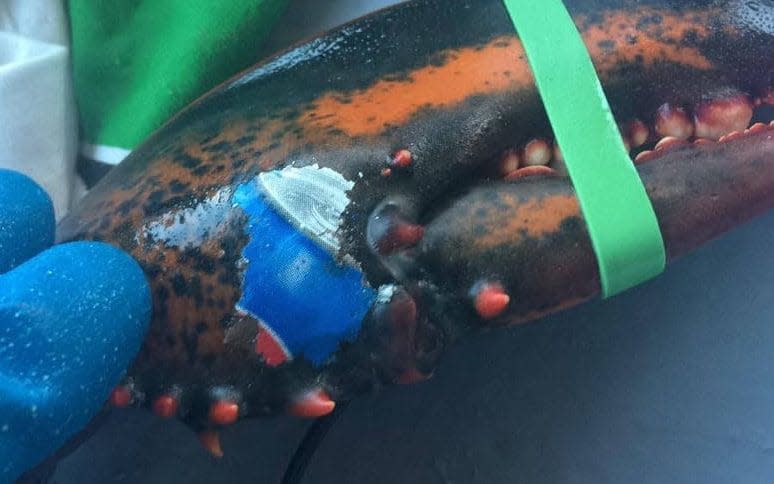Lobster with Pepsi logo 'tattoo' on its claw caught in Canada

A lobster caught in Canada with a Pepsi logo imprinted on its claw is drawing attention to the harmful impact rubbish can have on the ocean, conservationists say.
The branded crustacean was trapped by a fishing crew off the Canadian island of Grand Manan, New Brunswick, on 21 November.
Karissa Landstrand told CBC she was banding and loading lobsters into a crate for transportation to a buyer when she spotted the instantly recognisable red and blue logo of the fizzy drink.
“I can't say how he got it on,” Ms Lindstrand, who posted the image on Facebook, said. “It seemed more like a tattoo or a drawing on the lobster rather than something growing into it.”
She told Canadian media it appeared as if the logo was “tattooed on the lobster’s claw”, causing a debate among the crew working on the boat, however she could not explain how it got there.
“They believe that maybe there was a can in the bottom of the ocean and when [the lobster] was growing, it grew around the can,” said Ms Lindstrand, who has been lobster fishing for four years.
Another speculated that cardboard Pepsi packaging may have been stuck on its claw for years, with Ms Landstrand adding it could be scraped off but was not paper.
“This tells me that there is a lot of garbage in the ocean, if that’s what’s happening to the lobsters we get out from the water,” she added.
In numbers | Plastic in the sea
Matthew Abbott, a marine program coordinator at the Conservation Council of New Brunswick, said it showed “garbage [is] infiltrating even into the deep water”.
“I was surprised by unique turn of events that led to this lobster being imprinted with an image of a Pepsi can, but sadly not surprised that marine animals, even found at some depth, are coming into contact with human waste,” he told The Telegraph.
“It certainly helps illustrate how widespread marine debris is. While we often think of marine debris as being on the surface it is indeed spread throughout the water column both as large pieces and micro-plastics.
“This may have been a fairly harmless case, but often when marine animals come into contact with human rubbish the outcome is much worse. Whales, seals, dolphin, porpoise, sharks, fish, turtles can all be harmed and even killed by rope, net, and other debris in the water and in the water; animals from the smallest plankton to the largest whales can be hurt or killed when they ingest plastic rubbish.
“Ocean rubbish a big problem in New Brunswick, and sadly it is globally. Every time I walk local beaches or head out on the water on our Fundy Baykeeper patrol boat I find garbage both from local industries as well as trash from individuals.”
The non-profit organisation said it “tells the story of a dishearteningly common and pervasive problem in our oceans: the abundance of human-made garbage”.
A recent Blue Planet II episode focused on how plastic is having a devastating effect on the ocean and slowly poisoning our sea creatures, leaving many viewers shocked.
Sea creatures in the Mariana Trench, the deepest place on Earth, were also found to have plastic in their stomachs, scientists recently discovered.

